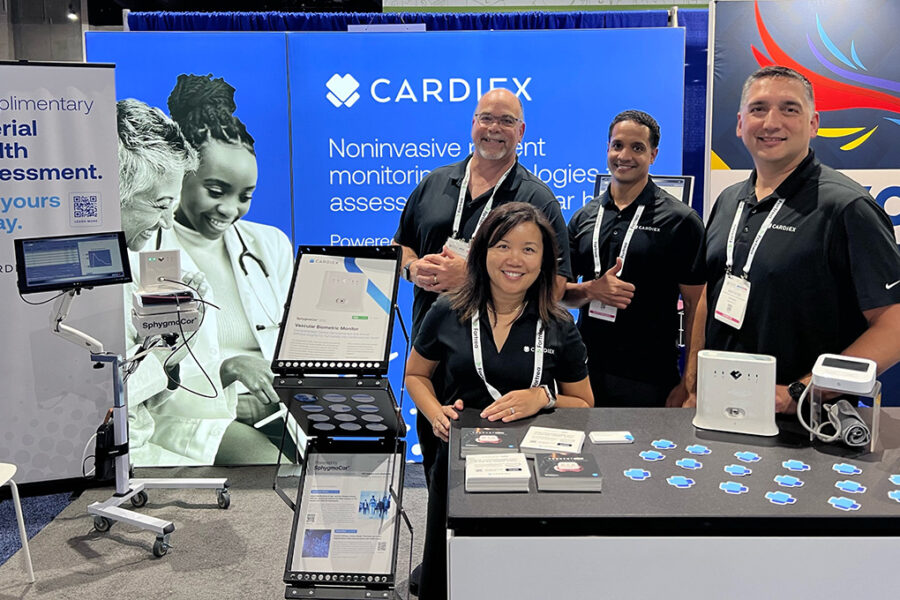
Understanding Uncontrolled High Blood Pressure and the Benefits of Measuring Central Blood Pressure (cBP)
June 20, 2019
Arterial Stiffness and Alzheimer’s Disease – What’s the Link?
January 6, 2020Measuring Brachial Blood Pressure vs Central Blood Pressure and Arterial Stiffness – What Works Best?
It’s no secret: high blood pressure is currently the most reliable and strongest modifiable risk factor known to medicine for cardiovascular disease. In fact, evidence suggests that we can prevent up to 80 percent of cardiovascular disease by making healthy lifestyle choices, including following a nutritious diet, getting sufficient exercise, avoiding drug and tobacco use, maintaining a healthy body weight, and using alcohol in moderation.
When it comes to measuring blood pressure, there are basically two approaches, and they are not equally accurate or diagnostic. The two methods in question are brachial blood pressure (BP) and central (aortic) blood pressure (cBP).
Brachial blood pressure does not give you the full picture
Brachial blood pressure measurement is by far the more common way blood pressure is currently taken. Simply, the pressure is measured on the brachial artery, which is palpable on the front (anterior) of the elbow, in the middle of the tendon of the biceps, typically using a blood pressure cuff.
When arterial blood pressure is measured using a blood pressure cuff, the systolic and diastolic values represent the pressure within the brachial artery on the arm. This pressure differs from the pressure found in the aorta. That’s because as the aortic pressure pulse (the difference between the systolic and diastolic pressures) travels down the aorta into other arteries (which distribute the blood to other parts of the body), characteristic changes occur in both the systolic and diastolic pressures, as well as in the mean pressure.
More specifically, the systolic pressure rises and the diastolic pressure falls while the pulse pressure increases. This occurs because of reflective waves when the blood branches off into the other arteries and because of increased blood vessel stiffness as the pressure pulse moves away from the aorta into the other arteries.
The importance of measuring central (aortic) blood pressure and arterial stiffness
Central blood pressure is the pressure found in the ascending aorta, which is just outside the left ventricle. This is the blood pressure that the target organs—kidneys, heart, brain, and arteries—are exposed to. Therefore, this is the blood pressure information that is most important for physicians and patients to have in order to determine the possibility of end organ damage and other complications associated with elevated blood pressure.
Central blood pressure can be taken in several ways. One is to use a tonometer, a small wand-like instrument that is placed on the skin over the brachial artery. The wand takes the pulse and peripheral blood pressure values together, and the central blood pressure is calculated using a formula. Another approach is to use a regular blood pressure cuff that is attached to a specialized device like AtCor Medical’s XCEL SphygmoCor that takes the pulse waveform and provides central blood pressure measurements.
Along with taking central blood pressure, it is also important to determine the degree of arterial stiffness. If you’re thinking “atherosclerosis” or “hardening of the arteries,” you’re in the ballpark. Arterial stiffness is a byproduct of aging and is the amount of stiffness or rigidness of the arterial walls. It is mainly determined by components of the arterial wall, such as elastin, collagen, and vascular smooth muscle tone, among others.
An accurate assessment of the integrity of the arterial wall could help physicians better predict a patient’s cardiovascular risk. Stiffening of the arteries damages the capillaries that nourish your organs, which means organ damage is very possible. The damage could manifest in various ways: stroke, dementia, kidney failure, a heart attack, or other disorders.(1,2)
The easiest way to measure arterial stiffness is measuring pulse pressure, and that information can also be ascertained when taking central blood pressure, not brachial blood pressure. That’s why more and more doctors need to adopt the practice of taking central blood pressure and accessing arterial stiffness in their patients, especially those at risk for cardiovascular disease. In fact, increased arterial stiffness is an accurate predictor of future cardiovascular events as well as all-cause mortality, independent of traditional risk factors for cardiovascular disease.3,4
Focus on central systolic blood pressure
One of the best tools physicians can use to effectively evaluate patients with hypertension to determine their risk of target-organ damage is to assess central systolic blood pressure, which differs from conventionally measured brachial systolic blood pressure.(5)
It’s important to point out that even among people who have similar brachial systolic blood pressures, there can be significant differences in central systolic values. Another factor to consider is that use of blood pressure medication can have an impact on brachial and central systolic blood pressures differently – which is an important factor for physicians to know before prescribing treatment. (6-9)
It also appears that central blood pressure and how it fluctuates in the presence of hypertensive medication is more strongly associated with end-organ damage than is brachial blood pressure. (10)
Therefore, as suggested by the findings of a randomized trial, it would seem that an accurate estimation of central blood pressure would help doctors improve how they manage their patients with high blood pressure.(11)
After all, if you want to know what is actually going on at the heart and other key organs, isn’t it fundamental to actually measure the blood pressure directly at those organs and not the arm?
References
1. Thorin-Trescases N, Thorin E. Lifelong cyclic mechanical strain promotes large elastic artery stiffening: increased pulse pressure and old age-related organ failure. Canadian Journal of Cardiology 2016; 32(5): 624-33
2. Safar ME et al. Pulse pressure, arterial stiffness, and end-organ damage. Current Hypertension Reports 2012 Aug; 14(4): 339-44
3. Vlachopoulos C et al. Prediction of cardiovascular events and all-cause mortality with central haemodynamics: a systematic review and meta-analysis. European Heart Journal 2010; 31: 1865–71.
4. Ben-Shlomo Y et al. Aortic pulse wave velocity improves cardiovascular event prediction: an individual participant meta-analysis of prospective observational data from 17,635 subjects. Journal of the American College of Cardiology 2014; 63: 636–46.
5. Herbert A et al. Establishing reference values for central blood pressure and its amplification in a general healthy population and according to cardiovascular risk factors. European Heart Journal 2014; 35: 3122–33.
6. Pucci G et al. Effects of β-blockers with and without vasodilating properties on central blood pressure: systematic review and meta-analysis of randomized trials in hypertension. Hypertension 2016; 67: 316–24.
7. Williams B et al. Differential impact of blood pressure-lowering drugs on central aortic pressure and clinical outcomes: principal results of the Conduit Artery Function Evaluation (CAFE) study. Circulation 2006; 113: 1213–25.
8. Boutouyrie P et al. Amlodipine-valsartan combination decreases central systolic blood pressure more effectively than the amlodipine-atenolol combination: the EXPLOR study. Hypertension 2010; 55: 1314–22.
9. Asmar RG et al. Improvement in blood pressure, arterial stiffness and wave reflections with a very-low-dose perindopril/ indapamide combination in hypertensive patient: a comparison with atenolol. Hypertension 2001; 38: 922–26.
10. Kollias A et al. Association of central versus brachial blood pressure with target-organ damage: systematic review and meta-analysis. Hypertension 2016; 67: 183–90.
11. Sharman JE et al. Randomized trial of guiding hypertension management using central aortic blood pressure compared with best-practice care: principal findings of the BP GUIDE study. Hypertension 2013; 62: 1138–45.



